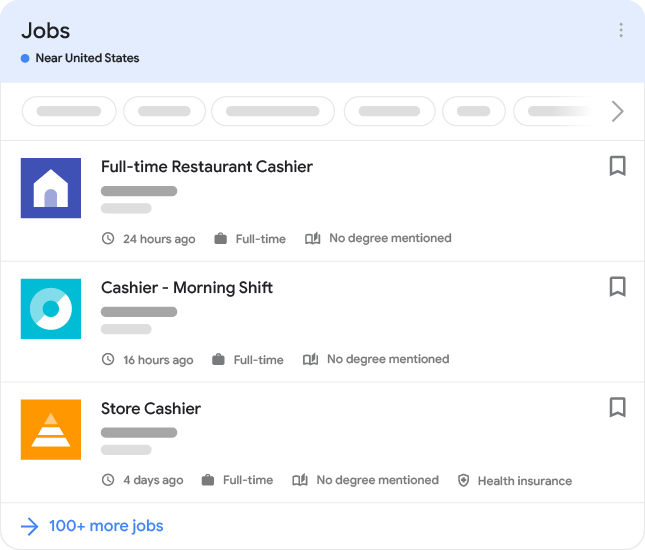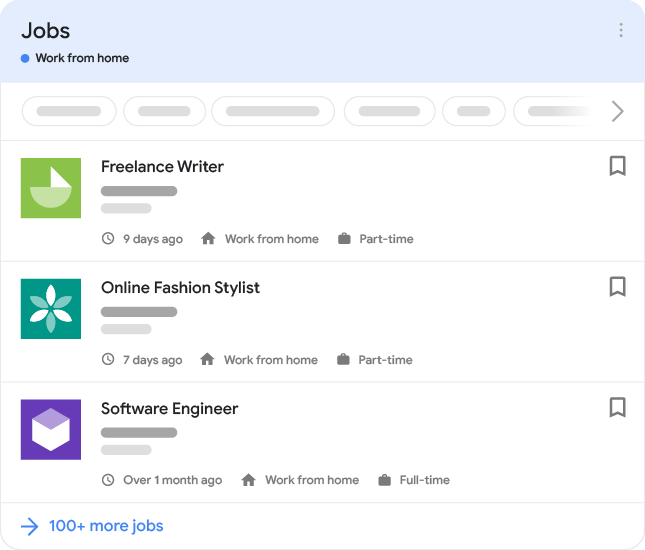Structured Data สำหรับประกาศรับสมัครงาน (JobPosting) สําหรับ Job Search
ปรับปรุงประสบการณ์การหางานให้ดีขึ้นได้ด้วยการเพิ่ม Structured Data JobPosting ลงในหน้าเว็บประกาศรับสมัครงาน การเพิ่ม Structured Data ช่วยให้ประกาศรับสมัครงานของคุณมีสิทธิ์แสดงในประสบการณ์พิเศษของผู้ใช้ในผลการค้นหาของ Google Search คุณยังผสานรวมกับ Google โดยใช้เว็บไซต์รับสมัครงานของบุคคลที่สามได้ด้วย

ฟีเจอร์นี้มีข้อดีหลายประการสำหรับนายจ้างและเจ้าของเว็บไซต์ที่มีเนื้อหาเกี่ยวกับงานดังนี้
- ผลการค้นหาที่เป็นแบบอินเทอร์แอกทีฟมากขึ้น: ประกาศรับสมัครงานของคุณอาจมีสิทธิ์แสดงในประสบการณ์การค้นหางานใน Google โดยมีทั้งโลโก้ รีวิว การให้คะแนน และรายละเอียดของตำแหน่งงาน
- ดึงดูดผู้สมัครที่สนใจได้มากยิ่งขึ้น: ประสบการณ์ของผู้ใช้แบบใหม่ช่วยให้ผู้หางานกรองตามเกณฑ์ต่างๆ ได้ เช่น สถานที่ทำงานหรือตำแหน่งงาน ซึ่งช่วยให้คุณดึงดูดผู้สมัครที่มองหางานในตำแหน่งนั้นจริงๆ
- เพิ่มโอกาสในการค้นพบและ Conversion: ผู้หางานจะมีพื้นที่ใหม่ไว้โต้ตอบกับประกาศและคลิกผ่านไปยังเว็บไซต์ของคุณได้
วิธีเพิ่ม Structured Data
ข้อมูลที่มีโครงสร้างคือรูปแบบมาตรฐานในการแจ้งข้อมูลเกี่ยวกับหน้าและจำแนกประเภทเนื้อหาของหน้า หากคุณเพิ่งใช้ข้อมูลที่มีโครงสร้างเป็นครั้งแรก โปรดดูข้อมูลเพิ่มเติมเกี่ยวกับวิธีการทำงานของข้อมูลที่มีโครงสร้าง
ต่อไปนี้เป็นภาพรวมเกี่ยวกับวิธีสร้าง ทดสอบ และเผยแพร่ Structured Data
- ตรวจสอบว่า Googlebot ทำการ Crawl เว็บไซต์ได้อย่างมีประสิทธิภาพ
- หากคุณมีสำเนาประกาศรับสมัครงานเดียวกันหลายรายการในเว็บไซต์ที่โฮสต์ไว้ภายใต้ URL ที่ต่างกัน ให้ใช้ Canonical URL ในสำเนาแต่ละรายการของหน้า
- เพิ่มพร็อพเพอร์ตี้ที่จำเป็นและแนะนำ ดูตำแหน่งการแทรก Structured Data ในหน้าเว็บตามรูปแบบที่คุณใช้อยู่
- ปฏิบัติตามหลักเกณฑ์ทางเทคนิคและนโยบายเนื้อหาของประกาศรับสมัครงาน
- ตรวจสอบความถูกต้องของโค้ดโดยใช้การทดสอบผลการค้นหาที่เป็นสื่อสมบูรณ์ นอกจากนี้คุณยังแสดงตัวอย่าง Structured Data ของคุณใน Google Search เพื่อดูว่ามีลักษณะเป็นอย่างไรได้อีกด้วย
- ทำให้หน้าบางหน้าที่มี Structured Data ใช้งานได้และใช้เครื่องมือตรวจสอบ URL เพื่อทดสอบว่า Google เห็นหน้าในลักษณะใด ตรวจสอบว่า Google เข้าถึงหน้าดังกล่าวได้และไม่มีการบล็อกหน้าด้วยไฟล์ robots.txt, แท็ก
noindexหรือข้อกำหนดให้เข้าสู่ระบบ หากหน้าเว็บดูถูกต้องดีแล้ว คุณขอให้ Google ทำการ Crawl URL อีกครั้งได้ - แจ้งให้ Google ทราบโดยใช้ Indexing API และส่ง Sitemap
สำหรับ URL ประกาศรับสมัครงาน ขอแนะนำให้ใช้ Indexing API แทน Sitemap เนื่องจาก Indexing API จะแจ้ง Googlebot ให้ทำการ Crawl หน้าเว็บของคุณเร็วกว่า ใช้ Indexing API เพื่อแจ้ง Google เกี่ยวกับ URL ใหม่ๆ ที่จะทำการ Crawl หรือแจ้งว่าเนื้อหาใน URL หนึ่งๆ มีการอัปเดต
อย่างไรก็ตาม เรายังคงแนะนำให้คุณส่ง Sitemap เพื่อการครอบคลุมทุกส่วนในเว็บไซต์ เรานำเข้าทั้ง Sitemap และทำการ Crawl หน้าต่างๆ อีกครั้ง ซึ่งมีเวลา
lastmodที่เป็นปัจจุบันมากกว่าเวลาที่มีการ Crawl หน้าเหล่านั้นครั้งล่าสุด
ตัวอย่าง
ประกาศรับสมัครงานมาตรฐาน
ต่อไปนี้คือตัวอย่างประกาศรับสมัครงานรายการหนึ่งที่ใช้โค้ด JSON-LD
<html>
<head>
<title>Software Engineer</title>
<script type="application/ld+json">
{
"@context" : "https://schema.org/",
"@type" : "JobPosting",
"title" : "Software Engineer",
"description" : "<p>Google aspires to be an organization that reflects the globally diverse audience that our products and technology serve. We believe that in addition to hiring the best talent, a diversity of perspectives, ideas and cultures leads to the creation of better products and services.</p>",
"identifier": {
"@type": "PropertyValue",
"name": "Google",
"value": "1234567"
},
"datePosted" : "2024-01-18",
"validThrough" : "2024-03-18T00:00",
"employmentType" : "CONTRACTOR",
"hiringOrganization" : {
"@type" : "Organization",
"name" : "Google",
"sameAs" : "https://www.google.com",
"logo" : "https://www.example.com/images/logo.png"
},
"jobLocation": {
"@type": "Place",
"address": {
"@type": "PostalAddress",
"streetAddress": "1600 Amphitheatre Pkwy",
"addressLocality": "Mountain View",
"addressRegion": "CA",
"postalCode": "94043",
"addressCountry": "US"
}
},
"baseSalary": {
"@type": "MonetaryAmount",
"currency": "USD",
"value": {
"@type": "QuantitativeValue",
"value": 40.00,
"unitText": "HOUR"
}
}
}
</script>
</head>
<body>
</body>
</html>ประกาศรับสมัครงานที่ทำจากบ้าน
ต่อไปนี้คือตัวอย่างประกาศรับสมัครงานที่ทำจากบ้านที่ใช้โค้ด JSON-LD
<html>
<head>
<title>Software Engineer</title>
<script type="application/ld+json">
{
"@context" : "https://schema.org/",
"@type" : "JobPosting",
"title" : "Software Engineer",
"description" : "<p>Google aspires to be an organization that reflects the globally diverse audience that our products and technology serve. We believe that in addition to hiring the best talent, a diversity of perspectives, ideas and cultures leads to the creation of better products and services.</p>",
"identifier": {
"@type": "PropertyValue",
"name": "Google",
"value": "1234567"
},
"datePosted" : "2024-01-18",
"validThrough" : "2024-03-18T00:00",
"applicantLocationRequirements": {
"@type": "Country",
"name": "USA"
},
"jobLocationType": "TELECOMMUTE",
"employmentType": "FULL_TIME",
"hiringOrganization" : {
"@type" : "Organization",
"name" : "Google",
"sameAs" : "https://www.google.com",
"logo" : "https://www.example.com/images/logo.png"
},
"baseSalary": {
"@type": "MonetaryAmount",
"currency": "USD",
"value": {
"@type": "QuantitativeValue",
"value": 40.00,
"unitText": "HOUR"
}
}
}
</script>
</head>
<body>
</body>
</html>นำประกาศรับสมัครงานออก
หากต้องการนำประกาศรับสมัครงานที่ไม่ได้ใช้แล้วออก ให้ทำตามขั้นตอนต่อไปนี้
- ตรวจสอบว่ามีการนำหน้าเว็บออกแล้วโดยทำอย่างใดอย่างหนึ่งต่อไปนี้
- ดูแลให้มีการสร้างพร็อพเพอร์ตี้
validThroughและค่าในพร็อพเพอร์ตี้อยู่ในอดีต - นำออกทั้งหน้า (เพื่อให้แสดงรหัสสถานะ
404หรือ410เมื่อมีการขอหน้านี้) - นำ Structured Data
JobPostingออกจากหน้า
- ดูแลให้มีการสร้างพร็อพเพอร์ตี้
- แจ้งให้ Google ทราบเกี่ยวกับการเปลี่ยนแปลงต่างๆ โดยทำดังนี้
- ใช้ Indexing API เพื่อขอให้นำ URL ประกาศรับสมัครงานออกจากดัชนีของ Google Search
เรานำเข้า Sitemap ทั้งแผนผังและทำการ Crawl หน้าต่างๆ อีกครั้ง ซึ่งมีเวลา
lastmodที่เป็นปัจจุบันมากกว่าเวลาที่มีการ Crawl หน้าเหล่านั้นครั้งล่าสุด
- ใช้ Indexing API เพื่อขอให้นำ URL ประกาศรับสมัครงานออกจากดัชนีของ Google Search
มาร์กอัปงานที่ทำจากบ้าน
เราขอแนะนำให้คุณเพิ่ม Structured Data ลงในงานที่ทำจากบ้านเพื่อให้ผู้หางานค้นพบโอกาสในการทำงานจากที่บ้านและจากระยะไกลได้ง่ายขึ้น
งานที่ทำจากบ้านจะปรากฏใน Google Search ในลักษณะต่อไปนี้

คุณยังลองดูใน Google Search ได้ด้วย โดยค้นหาดังนี้
พร็อพเพอร์ตี้ 3 รายการต่อไปนี้ช่วยให้ Google เข้าใจว่างานใดทำจากบ้านได้
jobLocationType: ใช้พร็อพเพอร์ตี้นี้เพื่อระบุว่างานนั้นเป็นงานที่ทำจากบ้านapplicantLocationRequirements: ใช้พร็อพเพอร์ตี้นี้เพื่อระบุสถานที่ตั้งทางภูมิศาสตร์ที่พนักงานอาจไปอยู่สำหรับงานที่ทำจากบ้าน ต้องระบุอย่างน้อย 1 ประเทศjobLocation: ใช้พร็อพเพอร์ตี้นี้เพื่อระบุสถานที่ตั้งจริงที่จะไปทำงานนั้นได้ คุณไม่จำเป็นต้องใช้พร็อพเพอร์ตี้นี้หากไม่มีสถานที่ตั้งจริงที่จะไปทำงานได้ (เช่น สำนักงานหรือสถานที่ก่อสร้าง) โปรดทราบว่าคุณต้องระบุพร็อพเพอร์ตี้addressCountryหากใช้พร็อพเพอร์ตี้นี้
ตัวอย่างสถานการณ์ทั่วไปของงานที่ทำจากบ้านมีดังนี้
- งานนี้ทำจากที่บ้านได้ แต่มีข้อจำกัดของตำแหน่งทางภูมิศาสตร์ที่พนักงานต้องอยู่เพื่อให้ทำงานได้ พนักงานไม่จำเป็นต้องไปที่สถานที่ตั้งหรือสำนักงานจริง ใช้
applicantLocationRequirementsและjobLocationType"applicantLocationRequirements": { "@type": "Country", "name": "USA" }, "jobLocationType": "TELECOMMUTE"
- งานนี้ทำได้ที่สถานที่ทำงานจริงในเมืองดีทรอยต์ รัฐมิชิแกน หรือทำที่บ้านซึ่งอยู่ในสหรัฐฯ ใช้
jobLocationและjobLocationType"jobLocation": { "@type": "Place", "address": { "@type": "PostalAddress", "addressLocality": "Detroit", "addressRegion": "MI", "addressCountry": "US" } }, "jobLocationType": "TELECOMMUTE"
- งานนี้ทำได้ที่สถานที่ทำงานจริงในเมืองดีทรอยต์ หรือทำที่บ้านซึ่งอยู่ในรัฐมิชิแกนหรือเท็กซัส ใช้
jobLocation,jobLocationTypeและapplicantLocationRequirements"jobLocation": { "@type": "Place", "address": { "@type": "PostalAddress", "streetAddress": "555 Clancy St", "addressLocality": "Detroit", "addressRegion": "MI", "postalCode": "48201", "addressCountry": "US" } }, "applicantLocationRequirements": [{ "@type": "State", "name": "Michigan, USA" },{ "@type": "State", "name": "Texas, USA" }], "jobLocationType": "TELECOMMUTE"
อัปเดตโลโก้บริษัท
Google ใช้รูปโลโก้ประกาศรับสมัครงานเดียวกันกับรูปที่แสดงในการ์ดกราฟความรู้ของบริษัท คุณแนะนำให้เปลี่ยนได้หากต้องการใช้โลโก้อื่น หรือไม่เช่นนั้นก็ให้ระบุโลโก้ที่ต้องการ (ทั้งสำหรับการ์ดความรู้ของ Google และประกาศรับสมัครงานของบริษัท) โดยใช้ Structured Data
หากคุณมีเว็บไซต์รับสมัครงานของบุคคลที่สาม อาจใช้โลโก้อื่นสำหรับองค์กรนั้นๆ ซึ่งไม่ใช่รูปที่แสดงในการ์ดความรู้ของ Google ขององค์กร Google จะเลือกโลโก้ที่ดีที่สุดเพื่อแสดงในผลการค้นหาของ Search ไม่ว่าจะเป็นโลโก้การ์ดความรู้หรือโลโก้ hiringOrganization พร็อพเพอร์ตี้ logo แสดงได้เฉพาะในเว็บไซต์งานของคุณ และไม่ถือว่าเป็นโลโก้ Canonical ขององค์กร ดูข้อมูลเพิ่มเติมได้ใน hiringOrganization
หลักเกณฑ์ทางเทคนิค
- ใส่ Structured Data ในหน้าที่มีรายละเอียดมากที่สุด อย่าเพิ่ม Structured Data ลงในหน้าเว็บที่ใช้แสดงตำแหน่งงาน (เช่น หน้าผลการค้นหา) แต่ให้ใช้ Structured Data กับหน้าที่เจาะจงที่สุดซึ่งอธิบายตำแหน่งงาน 1 งานด้วยข้อมูลที่เกี่ยวข้อง
- เพิ่มพร็อพเพอร์ตี้
JobPostingสำหรับประกาศรับสมัครงานแต่ละรายการที่คุณต้องการโฆษณา Structured Data ต้องปรากฏในหน้าเดียวกันกับคำอธิบายตำแหน่งงานที่ผู้หางานอ่านจากเบราว์เซอร์ของตนได้ - พร็อพเพอร์ตี้ส่วนใหญ่ต้องเกิดขึ้นเพียงครั้งเดียวในหน้าเว็บประกาศรับสมัครงาน เว้นแต่คำอธิบายจะระบุไว้อย่างเจาะจงว่าเพิ่มได้มากกว่า 1 ครั้ง
หากคุณเลือกใช้ Sitemap เพื่อให้ Google ทราบเกี่ยวกับการเปลี่ยนแปลงใน URL ประกาศรับสมัครงาน ให้ปฏิบัติตามหลักเกณฑ์ทั่วไปสำหรับ Sitemap นอกจากนี้หลักเกณฑ์ Sitemap ดังต่อไปนี้ยังใช้กับ URL ประกาศรับสมัครงานด้วย
- ตรวจสอบว่า Googlebot เข้าถึง URL ในแผนผังเว็บไซต์ได้ ตรวจสอบว่า URL ที่คุณระบุในแผนผังเว็บไซต์ไม่ได้อยู่หลังไฟร์วอลล์หรือถูกไฟล์ robots.txt บล็อกไว้
- ใช้เวลาที่แม่นยำที่สุดเท่าที่ทำได้สำหรับค่า
<lastmod>(แผนผังเว็บไซต์),<pubDate>(RSS) หรือ<updated>(Atom) เพื่อระบุเวลาที่เพิ่มหรือเปลี่ยนแปลงหน้าเว็บ ค่านี้ต้องเป็นเวลาล่าสุดที่มีการเปลี่ยนแปลงเนื้อหาใน URL คุณต้องใช้เวลาที่แม่นยำเพราะแบนด์วิดท์การรวบรวมข้อมูลมีจำกัด และเวลาที่แม่นยำจะช่วยให้เราไม่ต้องรวบรวมข้อมูลหน้าที่ไม่มีการเปลี่ยนแปลงอีกครั้ง นอกจากนี้ ยิ่ง Google ต้องรวบรวมข้อมูลจากหน้าของคุณมากเท่าใด ก็ยิ่งต้องเพิ่มโหลดให้เซิร์ฟเวอร์ของคุณมากขึ้นเท่านั้น - อย่ารวมหน้าผลการค้นหา หน้ารายการ หรือหน้าแบบไดนามิกอื่นๆ ในแผนผังเว็บไซต์
- URL ในแผนผังเว็บไซต์ต้องมีหน้า Canonical ของประกาศรับสมัครงานแต่ละรายการ
นโยบายเนื้อหาของประกาศรับสมัครงาน
เราสร้างนโยบายเนื้อหาของประกาศรับสมัครงานเพื่อให้ผู้ใช้ได้พบกับงานที่เปิดรับอยู่ สอดคล้องกับความต้องการ และสมัครได้ง่าย ประกาศรับสมัครงานยังต้องเป็นไปตามหลักเกณฑ์ทั่วไปเกี่ยวกับ Structured Data และนโยบายสแปมสําหรับ Google Web Search หากพบเนื้อหาที่ละเมิดนโยบายเหล่านี้ เราจะดำเนินการตามความเหมาะสม ซึ่งอาจรวมถึงการดำเนินการโดยเจ้าหน้าที่และการนำประกาศรับสมัครงานออกจากการค้นหางานใน Google
เนื้อหาไม่มีความเกี่ยวข้อง
ใช้มาร์กอัป JobPosting ในหน้าเว็บที่มีประกาศรับสมัครงานเดี่ยวๆ เท่านั้น เราไม่อนุญาตให้ใช้มาร์กอัป JobPosting ในหน้าอื่น รวมถึงหน้าเว็บที่ไม่แสดงตำแหน่งงานใดๆ เลย
เนื้อหาไม่สมบูรณ์
เราไม่อนุญาตให้เผยแพร่ประกาศรับสมัครงานที่มีคำอธิบายงานที่ไม่ครบถ้วน
การสื่อให้เข้าใจผิด
เราไม่อนุญาตให้เผยแพร่ประกาศรับสมัครงานที่พยายามแอบอ้างบุคคลหรือองค์กรอื่น หรือมีส่วนร่วมในกิจกรรมที่มีเป้าหมายในการหลอกลวง ฉ้อฉล หรือทำให้ผู้อื่นเข้าใจผิด ซึ่งรวมถึงการกล่าวเป็นนัยด้วยความเท็จว่าเป็นพาร์ทเนอร์กับหรือได้รับการรับรองโดยบุคคลหรือองค์กรอื่น และยังรวมถึงการใช้หลายบัญชีเพื่อหลบเลี่ยงนโยบายของเรา หลีกเลี่ยงการบล็อก หรือลบล้างข้อจำกัดใดๆ ที่ใช้กับบัญชีของคุณ
ตัวอย่างการละเมิดนโยบาย ได้แก่
- งานหรือเนื้อหาที่นำเสนอนายจ้างในทางที่ไม่ถูกต้อง ไม่เป็นความจริง หรือไม่ตรงไปตรงมา
- ประกาศรับสมัครงานสำหรับงานปลอมหรืองานที่ไม่มีอยู่จริง รวมถึงประกาศรับสมัครงานที่มีจุดประสงค์หลักในการรวบรวมข้อมูลเกี่ยวกับผู้สมัคร แทนที่จะว่าจ้างผู้สมัครเหล่านี้
- ตำแหน่งงาน คำอธิบาย และรายละเอียดอื่นๆ ของงานที่มีการใช้คีย์เวิร์ดในทางที่ผิดเพื่อควบคุมการจัดอันดับการค้นหา
- การให้ข้อมูลตำแหน่งที่เป็นเท็จซึ่งไม่ตรงกับตำแหน่งจริงของงาน
- ประกาศรับสมัครงานในนามขององค์กรหรือบริษัทโดยไม่ได้รับอนุญาต
คำหยาบคายและภาษาที่ไม่เหมาะสม
เราไม่อนุญาตให้เผยแพร่ประกาศรับสมัครงานที่มีภาษาลามก หยาบคาย หรือไม่เหมาะสม
โฆษณาที่แฝงมาในรูปแบบประกาศรับสมัครงาน
เราไม่อนุญาตให้เผยแพร่เนื้อหาโปรโมชันที่แฝงมาในรูปแบบประกาศรับสมัครงาน เช่น เนื้อหาที่โพสต์โดยบุคคลที่สาม (เช่น โปรแกรมแอฟฟิลิเอต)
คำขอลบเนื้อหาตามกฎหมาย
หาก Google ได้รับการร้องเรียนว่าเนื้อหาในประกาศรับสมัครงานอาจละเมิดกฎหมาย เราจะจัดการประกาศรับสมัครงานตามนโยบายของ Search
ประกาศรับสมัครงานที่หมดอายุแล้ว
เราไม่อนุญาตให้เผยแพร่ประกาศรับสมัครงานที่หมดอายุแล้ว โดยหลักการแล้ว คุณควรนำประกาศรับสมัครงานที่หมดอายุแล้วออกจากเว็บไซต์ หากไม่ต้องการนำออก โปรดตรวจสอบว่าคุณสร้างพร็อพเพอร์ตี้ validThrough แล้วและค่าในพร็อพเพอร์ตี้อยู่ในอดีต วิธีนี้จะช่วยให้ผู้ค้นหาพบเฉพาะตำแหน่งงานที่ยังเปิดรับคนอยู่
งานที่ไม่มีช่องทางให้สมัครงาน
เราไม่อนุญาตให้เผยแพร่ประกาศรับสมัครงานที่ไม่มีช่องทางให้สมัคร ซึ่งรวมถึง
- ประกาศรับสมัครงานที่โฆษณากิจกรรม เช่น คำเชิญเข้าร่วมงานมหกรรมอาชีพ
- ประกาศรับสมัครงานที่ต้องเข้าสู่ระบบเพื่อดูคำอธิบายงาน ผู้ใช้ต้องดูรายละเอียดของประกาศรับสมัครงานได้ทันทีโดยไม่ต้องเข้าสู่ระบบ
การเก็บประวัติการทำงาน
ผู้เผยแพร่ประกาศจะขอเก็บรวบรวมประวัติการทำงานสำหรับตำแหน่งที่เปิดรับอยู่เท่านั้น เราอาจลบคำขอที่รวบรวมข้อมูลผู้สมัครแต่ไม่ได้เปิดรับสมัครอยู่ในขณะนี้
คำขอทำงาน
ประกาศรับสมัครงานต้องอธิบายตำแหน่งงานที่เปิดรับ รวมทั้งคุณสมบัติที่จำเป็น และระบุข้อมูลอื่นๆ ที่เกี่ยวข้องกับผู้ใช้ที่กำลังมองหางาน เราไม่อนุญาตให้เผยแพร่ประกาศรับสมัครงานซึ่งผู้สมัครงานเสนอว่าตนต้องการทำงาน
ต้องมีการชำระเงิน
เราไม่อนุญาตให้เผยแพร่ประกาศรับสมัครงานที่ผู้สมัครต้องชำระเงิน
เนื้อหาบทบรรณาธิการ
เพื่อให้มั่นใจว่าผู้ใช้จะเข้าใจเนื้อหาของคุณและสมัครงานได้ง่ายๆ เราจะไม่อนุญาตเนื้อหาที่มีลักษณะเป็นสแปม ซึ่งมีข้อความและรูปภาพที่บดบังเนื้อหา มีโฆษณาที่มากเกินไปและรบกวนความสนใจ หรือเนื้อหาที่ไม่เกิดประโยชน์ใดๆ ต่อประกาศรับสมัครงาน
เราไม่อนุญาตเนื้อหาที่ไม่ถูกหลักไวยากรณ์ ปฏิบัติตามกฎพื้นฐานด้านไวยากรณ์ที่มีผลบังคับใช้กับภาษาหรือระบบการเขียนของเนื้อหาของคุณ (เช่น การใช้ตัวพิมพ์ใหญ่ที่เหมาะสม การหลีกเลี่ยงการเขียนข้อความเป็นตัวพิมพ์ใหญ่ทั้งหมด) และใช้อักษรย่อหรือคำย่อที่เข้าใจกันอย่างกว้างขวางเท่านั้น
คำจำกัดความของประเภท Structured Data
ส่วนนี้จะอธิบายประเภท Structured Data ที่เกี่ยวข้องกับประกาศรับสมัครงาน
คุณต้องใส่พร็อพเพอร์ตี้ที่จำเป็นลงในเนื้อหาเพื่อให้มีสิทธิ์แสดงในประสบการณ์ค้นหางานใน Google Search คุณอาจใส่พร็อพเพอร์ตี้ที่แนะนำด้วยเพื่อให้ข้อมูลเพิ่มเติมเกี่ยวกับเนื้อหา ซึ่งจะช่วยให้ผู้ใช้ได้รับประสบการณ์ที่ดียิ่งขึ้น
JobPosting
ดูคำจำกัดความที่สมบูรณ์ของ JobPosting ได้ที่ schema.org/JobPosting
พร็อพเพอร์ตี้ที่ Google รองรับมีดังนี้
| พร็อพเพอร์ตี้ที่จำเป็น | |
|---|---|
datePosted |
วันที่ดั้งเดิมที่นายจ้างโพสต์งาน ในรูปแบบ ISO 8601 เช่น "2017-01-24" หรือ "2017-01-24T19:33:17+00:00" "datePosted": "2016-02-18" |
description |
คำอธิบายที่สมบูรณ์ของงานในรูปแบบ HTML
หลักเกณฑ์เพิ่มเติม
|
hiringOrganization |
องค์กรที่เปิดรับสมัครตำแหน่งงานดังกล่าว ต้องระบุชื่อบริษัท (เช่น "Starbucks, Inc") และไม่ใช่ชื่อสาขาที่รับสมัคร (เช่น “Starbucks สาขาถนนสุขุมวิท”) ตัวอย่างเช่น "hiringOrganization": { "@type": "Organization", "name": "MagsRUs Wheel Company", "sameAs": "http://www.magsruswheelcompany.com" }
หากองค์กรว่าจ้างงานแบบไม่ระบุตัวตน (เช่น เอเจนซีหางานในนามของนายจ้างที่ไม่ระบุตัวตนหรือนายจ้างโดยตรงในแพลตฟอร์มของคุณ) ให้ใช้ค่า "hiringOrganization": { "@type": "Organization", "name": "confidential" } โลโก้ในเว็บไซต์รับสมัครงานบุคคลที่สาม หากคุณมีเว็บไซต์รับสมัครงานของบุคคลที่สาม คุณสามารถใช้โลโก้ขององค์กรนั้นแทนรูปที่แสดงในการ์ดความรู้ของ Google ที่แสดงข้อมูลเกี่ยวกับองค์กร หากต้องการขอโลโก้อื่นสำหรับองค์กรที่เป็นผู้ว่าจ้าง ให้เพิ่มพร็อพเพอร์ตี้โลโก้ลงในอาร์เรย์ "hiringOrganization": { "@type": "Organization", "name": "MagsRUs Wheel Company", "sameAs": "http://www.magsruswheelcompany.com", "logo": "https://www.example.com/images/logo.png" } |
jobLocation |
สถานที่ตั้งจริงของธุรกิจที่พนักงานจะรายงานการมาทำงาน (เช่น สำนักงานหรือสถานที่ทำงาน) ซึ่งไม่ใช่สถานที่ที่ประกาศรับสมัครงาน ให้รวมพร็อพเพอร์ตี้ต่างๆ ไว้ให้มากที่สุด ยิ่งคุณระบุพร็อพเพอร์ตี้มากเท่าใด ผู้ใช้ก็จะได้เห็นประกาศรับสมัครงานที่มีคุณภาพสูงขึ้นเท่านั้น โปรดทราบว่าคุณต้องรวมพร็อพเพอร์ตี้ "jobLocation": { "@type": "Place", "address": { "@type": "PostalAddress", "streetAddress": "555 Clancy St", "addressLocality": "Detroit", "addressRegion": "MI", "postalCode": "48201", "addressCountry": "US" } } มีสถานที่ตั้งจริงหลายแห่ง หากงานมีสถานที่ตั้งหลายแห่ง ให้เพิ่มพร็อพเพอร์ตี้ งานระยะไกล สำหรับงานที่พนักงานอาจหรือต้องทำงานจากระยะไกลเต็มเวลา คุณต้องใช้ |
title |
ชื่อตำแหน่งงาน (ไม่ใช่ชื่อของประกาศรับสมัครงาน) เช่น "วิศวกรซอฟต์แวร์" หรือ "บาริสต้า" ตัวอย่างเช่น "title": "Software Engineer" แนวทางปฏิบัติที่ดีที่สุด
|
| พร็อพเพอร์ตี้ที่แนะนำ | |
|---|---|
applicantLocationRequirements |
สถานที่ตั้งทางภูมิศาสตร์ที่พนักงานอาจไปอยู่เพื่อให้ทำงานจากที่บ้านได้ คำอธิบายงานต้องระบุอย่างชัดเจนว่าผู้สมัครอาจต้องอยู่ในสถานที่ตั้งทางภูมิศาสตร์บางแห่งตามที่กำหนด จําเป็นต้องระบุพร็อพเพอร์ตี้นี้หากกำหนดให้ผู้สมัครต้องอยู่ในสถานที่ตั้งทางภูมิศาสตร์แห่งหนึ่ง (หรือมากกว่านั้น) และทำงานจากระยะไกล 100% ตัวอย่างต่อไปนี้แสดงงานที่ทำจากระยะไกลได้ทุกที่ภายในสหรัฐอเมริกา "applicantLocationRequirements": { "@type": "Country", "name": "USA" }, "jobLocationType": "TELECOMMUTE" ตัวอย่างต่อไปนี้แสดงงานที่ทำจากระยะไกลในแคนาดาหรือทำจากสถานที่ตั้งจริงในดีทรอยต์ รัฐมิชิแกนก็ได้ "jobLocation": { "@type": "Place", "address": { "@type": "PostalAddress", "streetAddress": "555 Clancy St", "addressLocality": "Detroit", "addressRegion": "MI", "postalCode": "48201", "addressCountry": "US" } }, "applicantLocationRequirements": { "@type": "Country", "name": "Canada" }, "jobLocationType": "TELECOMMUTE" |
baseSalary |
เงินเดือนฐานตามจริงของงานนี้ ตามที่นายจ้างระบุไว้ (ไม่ใช่ค่าโดยประมาณ) สำหรับ
ตัวอย่างเช่น "baseSalary": { "@type": "MonetaryAmount", "currency": "USD", "value": { "@type": "QuantitativeValue", "value": 40.00, "unitText": "HOUR" } } หากต้องการระบุช่วงเงินเดือน ให้กำหนด "baseSalary": { "@type": "MonetaryAmount", "currency": "USD", "value": { "@type": "QuantitativeValue", "minValue": 40.00, "maxValue": 50.00, "unitText": "HOUR" } } |
directApply |
ระบุว่า URL ที่เชื่อมโยงกับประกาศรับสมัครงานเปิดการรับสมัครงานโดยตรงสำหรับงานหรือไม่ เราให้คำจำกัดความประสบการณ์การสมัครโดยตรงว่าเป็นการกระทำที่ต้องดำเนินการโดยผู้ใช้เพื่อสมัครงานใดงานหนึ่ง ซึ่งหมายความว่าผู้ใช้จะพบกับขั้นตอนการสมัครที่รวดเร็วและไม่ยุ่งยากในหน้าของคุณโดยไม่มีขั้นตอนที่ไม่จำเป็นระหว่างทาง หากผู้ใช้ต้องคลิกสมัคร จากนั้นกรอกแบบฟอร์มสมัครงาน แล้วลงชื่อเข้าใช้หรือลงชื่อเข้าสู่ระบบมากกว่า 1 ครั้งในขั้นตอนการสมัครทั้งหมด นั้นหมายความว่าคุณไม่ได้มอบประสบการณ์การสมัครโดยตรง คุณมีแนวโน้มที่จะมอบประสบการณ์การสมัครโดยตรงหากคุณมอบประสบการณ์แบบใดแบบหนึ่งต่อไปนี้
|
employmentType |
ประเภทการว่าจ้าง ตัวอย่างเช่น "employmentType": "CONTRACTOR" เลือกค่าต่อไปนี้ 1 ค่าหรือมากกว่า โดยต้องตรงตามตัวพิมพ์ใหญ่-เล็ก
คุณระบุพร็อพเพอร์ตี้ "employmentType": ["FULL_TIME", "CONTRACTOR"] |
identifier |
ตัวระบุงานที่ไม่ซ้ำกันขององค์กรที่เป็นผู้ว่าจ้าง ตัวอย่างเช่น "identifier": { "@type": "PropertyValue", "name": "MagsRUs Wheel Company", "value": "1234567" } |
jobLocationType |
กำหนดค่า ข้อกำหนด
ตัวอย่างต่อไปนี้แสดงให้เห็นว่าพนักงานจะรายงานการมาทำงานได้ที่สถานที่ทำงานที่ตั้งอยู่ในเมืองทูซอน รัฐแอริโซนา หรือจะทำงานจากระยะไกลภายในสหรัฐอเมริกาก็ได้ "jobLocation": { "@type": "Place", "address": { "@type": "PostalAddress", "addressLocality": "Tucson", "addressRegion": "AZ", "addressCountry": "US" } }, "jobLocationType": "TELECOMMUTE" |
validThrough |
วันที่ที่ประกาศรับสมัครงานหมดอายุในรูปแบบ ISO 8601 เช่น "2017-02-24" หรือ "2017-02-24T19:33:17+00:00" ตัวอย่างเช่น "validThrough": "2017-03-18T00:00" หากประกาศรับสมัครงานไม่มีวันหมดอายุ หรือคุณไม่ทราบว่างานนี้จะหมดอายุเมื่อไร ก็ไม่ต้องระบุพร็อพเพอร์ตี้นี้ หากได้คนทำงานก่อนวันหมดอายุ ให้นำประกาศรับสมัครงานออก |
พร็อพเพอร์ตี้การศึกษาและประสบการณ์ (เบต้า)
นอกจากพอร์พเพอร์ตี้ JobPosting ที่แนะนำแล้ว คุณยังเพิ่มพร็อพเพอร์ตี้เบต้าต่อไปนี้ได้เพื่อเพิ่มข้อมูลเกี่ยวกับการศึกษาและประสบการณ์ในประกาศรับสมัครงาน
เนื่องจากเรายังอยู่ในขั้นตอนการพัฒนาวิธีที่เราใช้ข้อมูลนี้ คุณอาจไม่เห็นลักษณะที่ปรากฏหรือผลลัพธ์ใน Google Search โดยทันที
นี่คือตัวอย่างของประกาศรับสมัครงานที่กำหนดเกณฑ์ขั้นต่ำเป็นการศึกษาระดับปริญญาตรีและประสบการณ์ 3 ปี
<html>
<head>
<title>Software Engineer</title>
<script type="application/ld+json">
{
"@context" : "https://schema.org/",
"@type" : "JobPosting",
"title" : "Software Engineer",
"educationRequirements" : {
"@type" : "EducationalOccupationalCredential",
"credentialCategory" : "bachelor degree"
},
"experienceRequirements" : {
"@type" : "OccupationalExperienceRequirements",
"monthsOfExperience" : "36"
},
"description" : "<p>Google aspires to be an organization that reflects the globally diverse audience that our products and technology serve. We believe that in addition to hiring the best talent, a diversity of perspectives, ideas and cultures leads to the creation of better products and services.</p>",
"identifier": {
"@type": "PropertyValue",
"name": "Google",
"value": "1234567"
},
"datePosted" : "2024-01-18",
"validThrough" : "2024-03-18T00:00",
"employmentType" : "CONTRACTOR",
"hiringOrganization" : {
"@type" : "Organization",
"name" : "Google",
"sameAs" : "https://www.google.com",
"logo" : "https://www.example.com/images/logo.png"
},
"jobLocation": {
"@type": "Place",
"address": {
"@type": "PostalAddress",
"streetAddress": "1600 Amphitheatre Pkwy",
"addressLocality": ", Mountain View",
"addressRegion": "CA",
"postalCode": "94043",
"addressCountry": "US"
}
},
"baseSalary": {
"@type": "MonetaryAmount",
"currency": "USD",
"value": {
"@type": "QuantitativeValue",
"value": 40.00,
"unitText": "HOUR"
}
}
}
</script>
</head>
<body>
</body>
</html>| พร็อพเพอร์ตี้ที่แนะนำ (เบต้า) | |
|---|---|
educationRequirements |
ประวัติการศึกษาที่จำเป็นสำหรับประกาศรับสมัครงาน หากไม่มีข้อกำหนดด้านการศึกษา ให้ใช้ค่า พร็อพเพอร์ตี้นี้ใช้ซ้ำในอาร์เรย์ได้ ตัวอย่างเช่น "educationRequirements": [ { "@type": "EducationalOccupationalCredential", "credentialCategory": "bachelor degree" }, { "@type": "EducationalOccupationalCredential", "credentialCategory": "postgraduate degree" } ] |
educationRequirements.credentialCategory |
ระดับการศึกษาที่จำเป็นสำหรับประกาศรับสมัครงาน โปรดใช้ค่าใดค่าหนึ่งต่อไปนี้
นอกเหนือจากการเพิ่มพร็อพเพอร์ตี้นี้แล้ว คุณยังต้องอธิบายข้อกำหนดด้านการศึกษาในพร็อพเพอร์ตี้ |
experienceRequirements |
ประสบการณ์ที่จำเป็นสำหรับประกาศรับสมัครงาน หากไม่มีข้อกำหนด ให้ใช้ค่า
นอกเหนือจากการเพิ่มพร็อพเพอร์ตี้นี้แล้ว คุณยังต้องอธิบายข้อกำหนดด้านประสบการณ์ในพร็อพเพอร์ตี้ |
experienceRequirements.monthsOfExperience |
จํานวนเดือนขั้นต่ำของประสบการณ์สำหรับประกาศรับสมัครงาน หากมีข้อกําหนดด้านประสบการณ์ที่ซับซ้อนมากขึ้น ให้ใช้ประสบการณ์ที่เป็นระยะเวลาขั้นต่ำที่จำเป็นสำหรับผู้สมัครคนหนึ่งๆ ตัวอย่างเช่น
|
experienceInPlaceOfEducation |
บูลีน หากตั้งค่าเป็น "จริง" พร็อพเพอร์ตี้นี้จะระบุว่าประกาศรับสมัครงานจะยอมรับประสบการณ์แทนคุณสมบัติทางการศึกษาอย่างเป็นทางการหรือไม่ หากตั้งค่าเป็น "จริง" คุณต้องใส่ทั้งพร็อพเพอร์ตี้ |
การแก้ปัญหา
หากประสบปัญหาในการใช้หรือแก้ไขข้อบกพร่องของ Structured Data โปรดดูแหล่งข้อมูลต่อไปนี้ซึ่งอาจช่วยคุณได้
- หากคุณใช้ระบบจัดการเนื้อหา (CMS) หรือมีผู้อื่นดูแลเว็บไซต์ ให้ขอความช่วยเหลือจากฝ่ายสนับสนุนของระบบหรือผู้ดูแลเว็บดังกล่าว และอย่าลืมส่งต่อข้อความจาก Search Console ที่ระบุรายละเอียดปัญหาด้วย
- Google ไม่รับประกันว่าฟีเจอร์ที่ใช้ Structured Data จะแสดงในผลการค้นหา ดูรายการสาเหตุทั่วไปที่ Google อาจไม่แสดงเนื้อหาของคุณเป็นผลการค้นหาที่เป็นริชมีเดียได้ในหลักเกณฑ์ทั่วไปเกี่ยวกับ Structured Data
- Structured Data ของคุณอาจมีข้อผิดพลาดอยู่ ตรวจสอบรายการข้อผิดพลาดของ Structured Data และรายงาน Structured Data ที่แยกวิเคราะห์ไม่ได้
- หากมีการดำเนินการกับ Structured Data โดยเจ้าหน้าที่ในหน้าของคุณ ระบบจะไม่สนใจ Structured Data ในหน้าดังกล่าว (แม้ว่าหน้าจะยังปรากฏในผลการค้นหาของ Google Search ก็ตาม) วิธีแก้ปัญหาเกี่ยวกับ Structured Data คือใช้รายงานการดำเนินการโดยเจ้าหน้าที่
- อ่านหลักเกณฑ์อีกครั้งเพื่อดูว่าเนื้อหาของคุณละเมิดหลักเกณฑ์หรือไม่ ปัญหาอาจเกิดจากเนื้อหาที่เป็นสแปมหรือการใช้มาร์กอัปที่เป็นสแปม อย่างไรก็ตาม ปัญหาอาจไม่ได้เป็นปัญหาด้านไวยากรณ์ ซึ่งทำให้การทดสอบผลการค้นหาที่เป็นริชมีเดียระบุปัญหาเหล่านั้นไม่ได้
- แก้ปัญหาเกี่ยวกับผลการค้นหาที่เป็นริชมีเดียขาดหายไป/จำนวนรวมของผลการค้นหาที่เป็นริชมีเดียลดลง
- ขอให้อดทนรอระหว่างที่เราทำการ Crawl และจัดทำดัชนีอีกครั้ง และโปรดทราบว่าหลังจากที่คุณเผยแพร่หน้าหนึ่งๆ แล้ว อาจใช้เวลาหลายวันกว่า Google จะพบและทำการ Crawl หน้าดังกล่าว ดูคำถามทั่วไปเกี่ยวกับการรวบรวมข้อมูลและการจัดทำดัชนีได้ในคำถามที่พบบ่อยเกี่ยวกับการรวบรวมข้อมูลและการจัดทำดัชนีของ Google Search
- โพสต์คำถามในฟอรัม Google Search Central
หากประกาศรับสมัครงานไม่ปรากฏในผลการค้นหางานหรือคุณได้รับการดำเนินการโดยเจ้าหน้าที่สำหรับมาร์กอัปแบบมีโครงสร้างที่เป็นสแปมใน Search Console ให้ลองแก้ปัญหาที่พบบ่อยที่สุด หากยังประสบปัญหาอยู่ โปรดอ่านหลักเกณฑ์ของเรา
Structured Data อยู่ในหน้าที่ไม่ถูกต้อง
error สาเหตุของปัญหา: หน้าตำแหน่งงาน (หน้าผลการค้นหาที่มีประกาศรับสมัครงานอย่างน้อย 1 รายการ) มี Structured Data JobPosting ในหน้า Structured Data JobPosting ต้องอยู่ในหน้าประกาศรับสมัครงานเท่านั้น (หน้าที่มีตำแหน่งงานเดียวและไม่ใช่หน้าผลการค้นหา) คุณอาจได้รับข้อความจาก Search Console ว่า "การละเมิดนโยบาย Structured Data - หน้ารายชื่อต้องไม่มี Structured Data ของแต่ละงาน"
done แก้ปัญหา
- นำ Structured Data
JobPostingออกจากหน้ารายชื่อ วาง Structured DataJobPostingในหน้าที่มีไว้สำหรับประกาศรับสมัครงานเดี่ยวๆ เท่านั้น - เมื่อแก้ปัญหาแล้ว ให้ส่งเว็บไซต์เข้ามารับการพิจารณาอีกครั้ง
เนื้อหาไม่ตรงกับ Structured Data
error สาเหตุของปัญหา: หน้าเว็บมีเนื้อหาที่ไม่ตรงกับ Structured Data ในหน้า เช่น ชื่อของตำแหน่งงานในหน้าไม่ตรงกับค่าที่แสดงในพร็อพเพอร์ตี้ title นอกจากนี้อาจมีเนื้อหาที่เป็นสแปม เช่น ชื่อและคำอธิบายแบบคลิกเบต ตำแหน่งงานดูเป็นข้อมูลเท็จ หรือประกาศรับสมัครงานไม่ได้นำเสนอตำแหน่งงานจริง
อีกตัวอย่างหนึ่งคือเมื่อมีข้อมูลเงินเดือนในมาร์กอัปแต่ไม่มีอยู่ในหน้างาน ซึ่งถือว่าละเมิดต่อหลักเกณฑ์เนื้อหาด้วย เนื่องจากข้อมูลทั้งหมดในมาร์กอัปจะต้องแสดงอยู่ในหน้างาน
ดูรายการตัวอย่างทั้งหมดได้ในนโยบายเนื้อหาของเรา คุณอาจได้รับข้อความจาก Search Console ว่า "การละเมิดนโยบาย Structured Data - พบว่าเนื้อหาในหน้าต่างจาก Structured Data ในหน้า"
done แก้ปัญหา
- ยืนยันว่า Structured Data สอดคล้องกับเนื้อหาจริงในหน้านำเสนอตำแหน่งงานที่จะต้องทำ และไม่ทำให้ผู้ใช้เข้าใจผิด
- ใช้เครื่องมือตรวจสอบ URL เพื่อตรวจสอบว่าเนื้อหามองเห็นได้ในหน้าที่แสดงผล (Google จะเห็นหน้าของคุณเป็นหน้าที่แสดงผล)
- เมื่อแก้ปัญหาแล้ว ให้ส่งเว็บไซต์เข้ามารับการพิจารณาอีกครั้ง
ตำแหน่งงานที่หมดอายุยังเผยแพร่อยู่
error สาเหตุของปัญหา: เมื่อค้นหางานใน Google ผู้ใช้ยังคงเข้าถึงหน้าเว็บนั้นได้ แม้ว่าตำแหน่งงานจะหมดอายุแล้ว ปัญหาดังกล่าวมักจะเกิดจากสาเหตุดังต่อไปนี้
- ไม่มีพร็อพเพอร์ตี้
validThroughหรือไม่ได้ตั้งค่าให้อยู่ในอดีต - หน้านี้ยังคงเผยแพร่อยู่
- ขั้นตอนตัวเลือกการสมัครของประกาศรับสมัครงานนำทางไปยังหน้าประกาศรับสมัครงานที่หมดอายุ
- Structured Data
JobPostingยังปรากฏในหน้าอยู่ แม้ว่างานจะหมดอายุไปแล้ว
คุณอาจได้รับข้อความจาก Search Console ว่า "การละเมิดนโยบาย Structured Data - Structured Data JobPosting ในตำแหน่งงานที่หมดอายุไปแล้ว"
done แก้ปัญหา
- นำประกาศรับสมัครงานที่หมดอายุออกโดยทำอย่างใดอย่างหนึ่งต่อไปนี้
- ดูแลให้มีการสร้างพร็อพเพอร์ตี้
validThroughและค่าในพร็อพเพอร์ตี้อยู่ในอดีต - นำออกทั้งหน้า (เพื่อให้แสดงรหัสสถานะ
404หรือ410เมื่อมีการขอหน้านี้) - นำ Structured Data
JobPostingออกจากหน้า
- ดูแลให้มีการสร้างพร็อพเพอร์ตี้
- แจ้งให้ Google ทราบอยู่เสมอโดยใช้ Indexing API
- เมื่อแก้ปัญหาแล้ว ให้ส่งเว็บไซต์เข้ามารับการพิจารณาอีกครั้ง
ไม่มีตัวเลือกการสมัคร
error สาเหตุของปัญหา: ไม่มีช่องทางให้ผู้ใช้สมัครงานในหน้าประกาศรับสมัครงาน คุณอาจได้รับข้อความจาก Search Console ว่า "การละเมิดนโยบาย Structured Data - ส่งใบสมัครในหน้ารับสมัครงานไม่ได้"
done แก้ปัญหา
- ตรวจสอบว่ามีวิธีสมัครงานให้ผู้ใช้ในหน้า
- เมื่อแก้ปัญหาแล้ว ให้ส่งเว็บไซต์เข้ามารับการพิจารณาอีกครั้ง
โลโก้ไม่ถูกต้อง
error สาเหตุของปัญหา: เว็บไซต์ไม่มีการ์ดความรู้ของ Google หรือการ์ดความรู้แสดงโลโก้ที่ไม่ถูกต้องของเว็บไซต์ Google ใช้รูปโลโก้ประกาศรับสมัครงานเดียวกันกับรูปที่แสดงในการ์ดความรู้ของบริษัท ดูข้อมูลเพิ่มเติมเกี่ยวกับวิธีที่ Google เลือกโลโก้ได้ที่อัปเดตโลโก้บริษัทของคุณ
done แก้ปัญหา
วิธีแก้ปัญหามีด้วยกัน 2 วิธี ดังนี้
- ตรวจสอบว่าคุณระบุโลโก้ที่ถูกต้องด้วยพร็อพเพอร์ตี้
hiringOrganization.logoตรวจสอบว่าอัตราส่วนกว้างยาวของรูปภาพอยู่ระหว่าง 0.75 ถึง 2.5 การอัปเดต Structured Data จะเร็วกว่าการอัปเดตการ์ดความรู้ของ Google และคุณไม่จำเป็นต้องผ่านการยืนยันสำหรับการ์ดความรู้ - แนะนำการเปลี่ยนแปลงในการ์ดความรู้ การอัปเดตการ์ดความรู้ให้คุณควบคุมได้มากขึ้นว่าองค์กรจะปรากฏให้เห็นอย่างไรใน Google แต่อาจใช้เวลาอัปเดตนานกว่า หากต้องการแก้ปัญหาโลโก้อย่างรวดเร็ว ให้เพิ่มพร็อพเพอร์ตี้
hiringOrganization.logo
สถานที่ทำงานขาดหายไปหรือไม่ถูกต้อง
error สาเหตุของปัญหา: Google ไม่เข้าใจค่าที่ระบุไว้ของพร็อพเพอร์ตี้ jobLocation, addressLocality หรือ addressRegion Google พยายามจับคู่ข้อมูลตำแหน่งกับสถานที่ตั้งจริงและตำแหน่งที่ระบุขาดหายไปหรือไม่ถูกต้อง
done แก้ปัญหา
- ตรวจสอบว่า Structured Data มีค่าสำหรับ
jobLocation,addressLocalityหรือaddressRegion(ขึ้นอยู่กับสถานที่ทำงาน พร็อพเพอร์ตี้ตำแหน่งบางอย่างอาจไม่เกี่ยวข้อง) - ตรวจสอบความถูกต้องของการแก้ปัญหาเกี่ยวกับสถานที่ทำงานโดยทำดังนี้
- เปิดการทดสอบผลการค้นหาที่เป็นสื่อสมบูรณ์
- ป้อน URL ประกาศรับสมัครงานในช่องดึงข้อมูล URL
- คลิกตรวจสอบ
- คลิกดูตัวอย่าง
สำเร็จ: การทดสอบผลการค้นหาที่เป็นสื่อสมบูรณ์แสดงสถานที่ทำงานที่ถูกต้องในเครื่องมือแสดงตัวอย่างของ Google Search
ลองอีกครั้ง: การทดสอบผลการค้นหาที่เป็นสื่อสมบูรณ์แสดง "เท็จ" สำหรับสถานที่ทำงานในเครื่องมือแสดงตัวอย่างของ Google Search ตรวจสอบว่าตำแหน่งนั้นเป็นสถานที่ที่มีอยู่จริง
ตรวจสอบผลการค้นหาที่เป็นสื่อสมบูรณ์ด้วย Search Console
Search Console เป็นเครื่องมือที่ช่วยในการตรวจสอบประสิทธิภาพของหน้าเว็บใน Google Search คุณไม่จำเป็นต้องลงชื่อสมัครใช้ Search Console เพื่อให้เนื้อหาได้แสดงในผลการค้นหาของ Google แต่การลงชื่อสมัครใช้จะช่วยให้คุณเข้าใจและปรับปรุงวิธีที่ Google เห็นเว็บไซต์ได้ เราขอแนะนำให้ไปดูข้อมูลใน Search Console ในกรณีต่อไปนี้
- หลังจากทำให้ข้อมูลที่มีโครงสร้างใช้งานได้เป็นครั้งแรก
- หลังจากเผยแพร่เทมเพลตใหม่หรืออัปเดตโค้ด
- วิเคราะห์การเข้าชมเป็นระยะ
หลังจากทำให้ข้อมูลที่มีโครงสร้างใช้งานได้เป็นครั้งแรก
หลังจากที่ Google ได้จัดทำดัชนีหน้าของคุณแล้ว ให้ตรวจหาปัญหาโดยใช้รายงานสถานะผลการค้นหาที่เป็นสื่อสมบูรณ์ที่เกี่ยวข้อง ตามหลักแล้ว รายการที่ถูกต้องควรจะมีจํานวนเพิ่มขึ้น และรายการที่ไม่ถูกต้องไม่ควรจะมีจำนวนเพิ่มขึ้น หากพบปัญหาในข้อมูลที่มีโครงสร้าง ให้ทำดังนี้
- แก้ไขรายการที่ไม่ถูกต้อง
- ตรวจสอบ URL ที่เผยแพร่เพื่อดูว่ายังมีปัญหาอยู่หรือไม่
- ขอการตรวจสอบโดยใช้รายงานสถานะ
หลังจากเผยแพร่เทมเพลตใหม่หรืออัปเดตโค้ด
เมื่อทําการเปลี่ยนแปลงที่สําคัญในเว็บไซต์ ให้คอยตรวจสอบการเพิ่มขึ้นของรายการที่ไม่ถูกต้องของ Structured Data- หากเห็นว่าจำนวนรายการที่ไม่ถูกต้องเพิ่มขึ้น อาจเป็นเพราะคุณเผยแพร่เทมเพลตใหม่ที่ใช้งานไม่ได้ หรือเว็บไซต์โต้ตอบกับเทมเพลตที่มีอยู่ด้วยวิธีใหม่และไม่ถูกต้อง
- หากเห็นว่าจำนวนรายการที่ถูกต้องลดลง (ไม่สอดคล้องกับรายการที่ถูกต้องซึ่งเพิ่มขึ้น) บางทีอาจเป็นเพราะคุณไม่ได้ฝัง Structured Data ไว้ในหน้าอีกแล้ว ให้ใช้เครื่องมือตรวจสอบ URL เพื่อดูสาเหตุของปัญหา
วิเคราะห์การเข้าชมเป็นระยะ
วิเคราะห์การเข้าชมจาก Google Search โดยใช้รายงานประสิทธิภาพ ข้อมูลจะแสดงความถี่ที่หน้าปรากฏเป็นผลการค้นหาที่เป็นสื่อสมบูรณ์ใน Search ความถี่ที่ผู้ใช้คลิกหน้า และอันดับเฉลี่ยที่หน้าปรากฏในผลการค้นหา คุณจะใช้ Search Console API ดึงผลการค้นหาเหล่านี้โดยอัตโนมัติก็ได้เช่นกันใช้พารามิเตอร์ UTM ที่กำหนดเองใน Google Analytics
ใช้พารามิเตอร์ UTM ที่กำหนดเองเพื่อติดตามการเข้าชมหลังจากหน้ารายละเอียดงานนำผู้ใช้มายังเว็บไซต์ของคุณ คุณยังใช้พารามิเตอร์กับ Google Analytics หรือเครื่องมือติดตามของบุคคลที่สามอื่นๆ ต่อไปนี้ได้อีกด้วย
utm_campaign=google_jobs_apply
utm_source=google_jobs_apply
utm_medium=organic
หากพบความผันผวนหรือความไม่สอดคล้องที่ไม่คาดคิดในปริมาณการค้นหา ให้ใช้เครื่องมือแก้ปัญหาเพื่อระบุปัญหาและทำการแก้ไข
ความพร้อมใช้งานในภูมิภาค
Google มีแผนที่จะเปิดใช้ฟีเจอร์การค้นหางานในภูมิภาคต่างๆ ทั่วโลก ขณะนี้ฟีเจอร์นี้พร้อมใช้งานในภูมิภาคต่อไปนี้
- เอเชีย: พร้อมใช้งานในประเทศต่อไปนี้
- บังกลาเทศ
- ฮ่องกง
- อินเดีย
- อินโดนีเซีย
- ญี่ปุ่น
- คาซัคสถาน
- คีร์กีซสถาน
- มาเลเซีย
- ปากีสถาน
- ฟิลิปปินส์
- สิงคโปร์
- ศรีลังกา
- ไต้หวัน
- ไทย
- อุซเบกิสถาน
- เวียดนาม
- ยุโรป: พร้อมใช้งานในประเทศต่อไปนี้
- ออสเตรีย
- เบลารุส
- เบลเยียม
- เดนมาร์ก
- ฝรั่งเศส
- เยอรมนี
- กรีซ
- อิตาลี
- เนเธอร์แลนด์
- โปรตุเกส
- รัสเซีย
- สเปน
- สวิตเซอร์แลนด์
- สหราชอาณาจักร
- ลาตินอเมริกา: พร้อมใช้งานทั่วทั้งภูมิภาค
- ตะวันออกกลางและแอฟริกาเหนือ: พร้อมใช้งานในประเทศต่อไปนี้
- แอลจีเรีย
- บาห์เรน
- อียิปต์
- อิรัก
- จอร์แดน
- คูเวต
- เลบานอน
- ลิเบีย
- โมร็อกโก
- โอมาน
- ปาเลสไตน์
- กาตาร์
- ซาอุดีอาระเบีย
- ตูนิเซีย
- สหรัฐอาหรับเอมิเรตส์
- อเมริกาเหนือ: พร้อมใช้งานทั่วทั้งภูมิภาค
- แอฟริกาใต้สะฮารา: พร้อมใช้งานทั่วทั้งภูมิภาค
